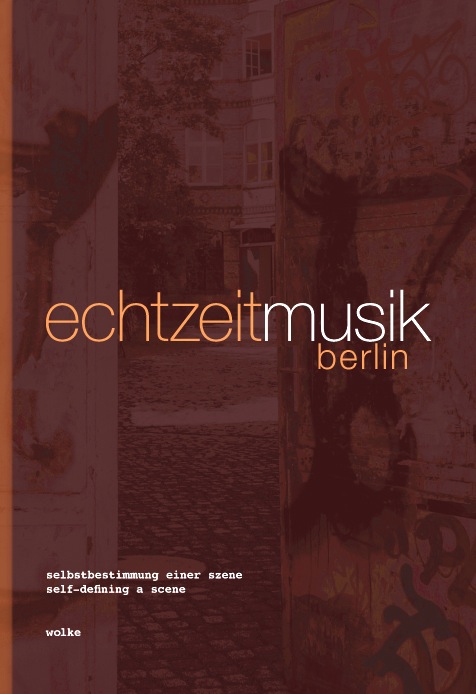
|
Burkhard Beins, Christian Kesten, Gisela Nauck, Andrea Neumann (editors)ECHTZEITMUSIK berlin
|
Theoretical texts, memories, statements and artwork
by Thomas Ankersmit, Harald Ansorge, Serge Baghdassarians, Boris Baltschun, Jürg Bariletti, Johannes Bauer, Burkhard Beins,
Marta Blazanovic, Nicholas Bussmann, Lucio Capece, Diego Chamy, Clare Cooper, Werner Dafeldecker, Rhodri Davies, Bertrand Denzler,
Bill Dietz, Axel Dörner, Phil Durrant, Ekkehard Ehlers, Sabine Ercklentz, Andrea Ermke, Kai Fagaschinski, Fernanda Farah, Kerstin Fuchs,
Björn Gottstein, Matthias Haenisch, Hanna Hartman, Franz Hautzinger, Robin Hayward, Sven-Åke Johansson,
Margareth Kammerer, Christian Kesten, Annette Krebs, Christof Kurzmann, Greg Malcolm, Thomas Meadowcroft, Chico Mello,
Thomas Millroth, Toshimaru Nakamura, Gisela Nauck, Vered Nethe, Andrea Neumann, Nina Polaschegg, Michael Renkel, Ana Maria Rodriguez,
Adeline Rosenstein, Arthur Rother, Olaf Rupp, Ignaz Schick, Ulf Sievers, Stefan Streich, T. Turner, Michael Vorfeld, Antje Vowinckel, and
Steffi Weismann
Chronological timeline and club list
Photo series of Berlin clubs by Teresa Iten
Reproductions of flyers, posters, and concert photos
List of musicians, selected discography, cover reproductions
Subject and name index
Shaped by the perspectives of participants and various observers, the book Echtzeitmusik - Self-Defining a Scene investigates, documents, and reflects
on a multilayered phenomenon within Berlin's musical culture, a phenomenon whose influence and meaning has effects that extend far beyond Berlin itself.
Having emerged in the open spaces of the city's east side after the fall of the Berlin Wall, and rooted in a cultural coordinate system made up of squats and
free improvisation, punk and New Music, social experimentation and performance art, the Echtzeitmusik scene has passed through an eventful history of musical
and social development and matured into a wide spectrum of predominantly experimental forms of music, bordering on fields as varied as noise, electronica,
trash pop, free jazz, and contemporary composed music, not to mention performance and sound art.
This book is a theoretical approach to a scene that constituates itself through practice, that describes itself with every single contribution here, that invents,
defines, and positions itself through writing. It is a verbal act of uncovering. There is not the history, but a myriad of histories, not the theory, but the widest
range of somewhat discordant conceptions and approaches. Echtzeitmusik - Self-Defining a Scene mirrors this multiperspectivity. It is more than a mere
documentation of the history of Echtzeitmusik, it might be considered a part of this history.
Aus der Perspektive der Beteiligten und einiger BeobachterInnen erforscht, dokumentiert und reflektiert das Buch Echtzeitmusik - Selbstbestimmung einer Szene
ein vielschichtiges Phänomen innerhalb der Berliner Musikkultur, dessen Einfluss und Bedeutung weit über die Stadt hinauswirkt. In den Freiräumen des Ostteils
der Stadt nach dem Mauerfall entstanden und in einem kulturellen Koordinatensystem aus Hausbesetzung und Freier Improvisation, Punk und Neuer Musik, sozialem
Experiment und Performancekunst wurzelnd, hat die Echtzeitmusik-Szene in den vergangenen zwei Jahrzehnten eine bewegte musikalische und soziale Entwicklungsgeschichte
durchlaufen und sich zu einer großen Bandbreite weitestgehend experimenteller Musikformen ausdifferenziert, die an so unterschiedliche Bereiche wie Noise,
Electronica, Trash-Pop, Free Jazz und zeitgenössische komponierte Musik, aber auch Performance- und Klangkunst angrenzen.
Dieses Buch ist eine theoretische Annäherung an eine aus der Praxis heraus sich konstituierende Szene, die mit jedem einzelnen Beitrag sich selbst beschreibt,
sich schreibend erfindet, bestimmt und positioniert. Ein Akt verbaler Sichtbarmachung. Es gibt nicht die Geschichte, sondern nur eine Vielzahl von Geschichten,
nicht die Theorie, sondern unterschiedlichste, teils widerstreitende Konzeptionen und Herangehensweisen. Echtzeitmusik - Selbstbestimmung einer Szene
spiegelt diese Multiperspektivität wider und vesteht sich nicht allein als eine Dokumentation einer Geschichte der Echtzeitmusik, sondern ist selbst Teil davon.
[ back to theory ]
[ back to releases ]
[ reviews ]